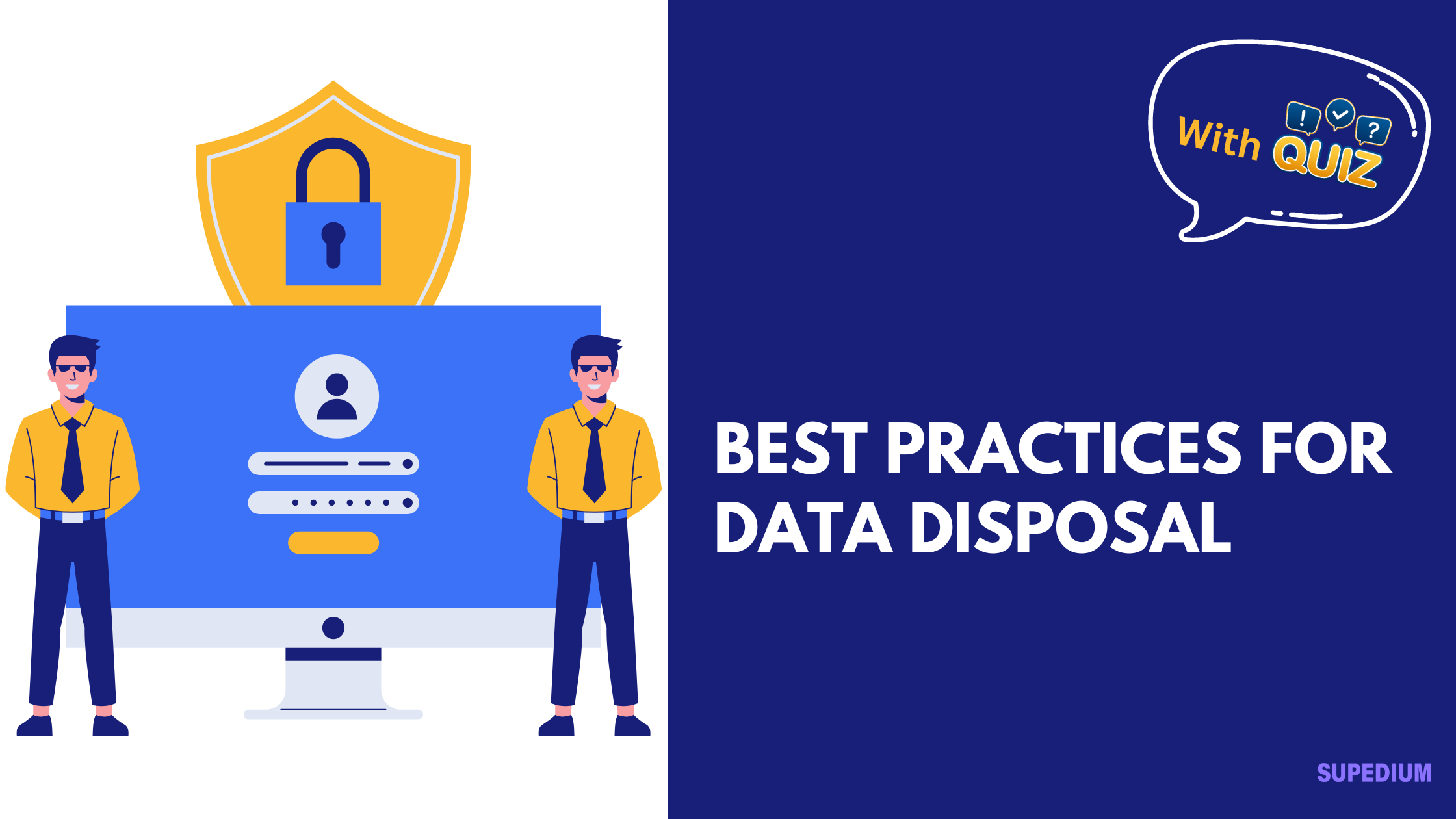Table of Contents
![]()
Introduction
Definition of Data Disposal
Data disposal refers to the process of securely eliminating data from storage devices to ensure that it cannot be recovered or misused. This encompasses not only deleting files but also taking steps to ensure that data is irretrievable. Proper data disposal is critical in protecting sensitive information and mitigating risks associated with data breaches.
Importance of Best Practices
Adhering to best practices in data disposal is essential for several reasons:
- Compliance with Regulations: Organizations must comply with various data protection laws and standards.
- Prevention of Data Breaches: Proper disposal methods prevent unauthorized access to sensitive information.
- Protection of Sensitive Information: Ensures that personal and confidential data is not exposed to misuse.
Regulatory and Legal Considerations
Overview of Data Protection Regulations
Organizations must navigate a complex landscape of data protection regulations, including:
- General Data Protection Regulation (GDPR): Enforces strict rules on data handling and disposal within the European Union.
- Health Insurance Portability and Accountability Act (HIPAA): Sets standards for data protection in the healthcare sector in the United States.
- Payment Card Industry Data Security Standard (PCI DSS): Requires secure handling of payment card information.
- Federal Information Processing Standards (FIPS): Provides guidelines for federal data management and security in the United States.
Legal Obligations for Data Disposal
Organizations are legally required to:
- Retain Records: Maintain certain records for specified periods based on regulations and industry standards.
- Avoid Consequences of Non-Compliance: Non-compliance can lead to significant penalties, including fines and reputational damage.
Industry-Specific Regulations
Different sectors have unique requirements:
- Financial Sector: Strict guidelines for handling and disposing of financial data.
- Healthcare Sector: Specific rules for disposing of patient records and other sensitive health information.
- Education Sector: Regulations regarding student data and institutional records.
Methods of Data Disposal
Physical Data Destruction
Shredding
Shredding involves cutting paper or other media into small pieces, making it difficult to reconstruct the data. Key considerations include:
- Types of Shredders: Cross-cut shredders offer more security than strip-cut shredders.
- Best Practices: Use high-quality shredders and ensure that all data-bearing materials are shredded.
Degaussing
Degaussing uses magnetic fields to disrupt the data on magnetic storage devices, rendering them unreadable. This method is effective for:
- How Degaussing Works: By demagnetizing the storage medium, degaussing ensures that data cannot be retrieved.
- Types of Degaussers: Devices vary in strength and effectiveness; choose according to the data density and type.
Incineration
Incineration involves burning data-bearing media to destroy it completely. Considerations include:
- Process of Incineration: A thorough method that ensures complete destruction of physical data.
- Environmental Considerations: Ensure compliance with environmental regulations and manage waste appropriately.
Digital Data Destruction
Software-Based Data Wiping
Data wiping software overwrites existing data to prevent recovery. Key points include:
- Overview of Data Wiping Tools: Tools vary in features and effectiveness; select based on security needs.
- Multi-Pass Wiping Standards: Standards like DoD 5220.22-M require multiple overwrite passes to ensure data is irretrievable.
Data Encryption
Encrypting data before disposal adds an extra layer of security:
- Importance of Encryption: Encrypting data makes it unreadable without the decryption key.
- Methods of Securely Deleting Encryption Keys: Ensure that encryption keys are securely deleted to prevent access to encrypted data.
Secure Erasure Techniques
Secure erasure involves methods and tools designed to permanently remove data:
- Overview of Secure Erasure Methods: Techniques such as NIST 800-88 provide guidelines for secure data erasure.
- Tools and Software Options: Various software solutions offer secure erasure features; select based on organizational needs.
Considerations for Different Media Types
Different media require specific disposal methods:
- Hard Drives and SSDs: Both require careful handling; SSDs may need special attention due to their technology.
- Optical Media (CDs, DVDs): Shredding or incineration is often used.
- Mobile Devices: Require secure wiping and physical destruction if necessary.
- Backup Tapes and Cloud Storage: Backup tapes should be degaussed or shredded; cloud storage data requires careful management of deletion processes.
Implementing a Data Disposal Policy
Developing a Data Disposal Policy
A comprehensive data disposal policy should include:
- Key Components: Procedures for data disposal, responsibilities, and compliance measures.
- Roles and Responsibilities: Define who is responsible for data disposal and ensure accountability.
Training and Awareness
Educate employees on data disposal practices:
- Educating Employees: Regular training helps staff understand the importance and methods of data disposal.
- Regular Training Sessions: Keep employees updated on best practices and regulatory changes.
Documentation and Record-Keeping
Maintain thorough records of data disposal:
- Maintaining Records: Document all disposal actions for auditing and compliance.
- Tracking and Auditing: Implement systems for tracking data disposal and conducting regular audits.
Best Practices for Ensuring Data Disposal Effectiveness
Verification of Data Destruction
Ensure that data destruction methods are effective:
- Techniques for Verification: Use tools and methods to verify that data has been successfully destroyed.
- Third-Party Verification Services: Consider third-party services for independent verification.
Handling of Sensitive Data
Special procedures are necessary for highly sensitive data:
- Special Procedures: Implement enhanced measures for handling and disposing of particularly sensitive information.
- Data Classification: Classify data according to sensitivity and apply appropriate disposal methods.
Disposal of Devices and Media
Proper disposal of devices and media involves:
- Best Practices: Follow industry guidelines for disposing of physical devices.
- Environmentally Responsible Options: Ensure that disposal methods comply with environmental regulations.
Emerging Trends and Technologies
Advances in Data Disposal Technology
New technologies and methods are constantly evolving:
- New Methods and Tools: Stay updated on advancements in data disposal technology.
- Role of AI and Automation: Explore how AI and automation can enhance data disposal processes.
Challenges and Future Considerations
Address future challenges in data disposal:
- Evolving Threats: Stay aware of emerging threats and adjust disposal practices accordingly.
- Cloud-Centric Data Disposal: Develop strategies for data disposal in a cloud-based environment.
Case Studies and Examples
Real-World Examples of Data Disposal Failures
Learn from past mistakes:
- Analysis of Failures: Review cases where improper disposal led to data breaches.
- Lessons Learned: Understand what went wrong and how to avoid similar issues.
Successful Data Disposal Practices
Study effective practices:
- Case Studies: Examine organizations with strong data disposal practices.
- Best Practices: Apply lessons from successful cases to improve your own processes.
Conclusion
Recap of Key Points
Proper data disposal is crucial for data protection and regulatory compliance:
- Summary: Ensure data is thoroughly destroyed using appropriate methods and tools.
- Importance: Follow best practices to prevent data breaches and protect sensitive information.
Final Recommendations
Implement actionable steps for effective data disposal:
- Actionable Steps: Develop and enforce a comprehensive data disposal policy.
- Ongoing Vigilance: Regularly review and update disposal practices to address evolving challenges.
By following these best practices, organizations can ensure that their data disposal processes are secure, compliant, and effective in protecting sensitive information.






Be the first to comment